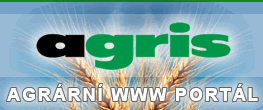THE EFFECT OF SEED PROPERTIES ON SPEED AND SPREAD OF SUGAR BEET FIELD EMERGENCE AND ROOT QUALITY
09.12.1999 | Odborné konference
Prof. Sławomir Podlaski
Department of Plant Breeding and Seed Science
Warsaw Agricultural University
Summary
In the laboratory biological, physical and physicochemical traits of seeds of different breeding stocks were measured. It was found that low (negative) osmotic potential of water extracts from fruits delays field emergence and increases inequality of emergence. Morphological traits, mainly root weight, depend on time of emergence of plant. Variability of root weight is correlated negatively to correctness of sugar beets topping.
Streszczenie
W badaniach laboratoryjnych określano cechy biologiczne, fizyczne i fizykochemiczne nasion należących do różnych rodów hodowlanych. Stwierdzono, że niski (ujemny) potencjał osmotyczny ekstraktów wodnych z owoców opóźnia wschody polowe i zwiększa równomierność. Cechy morfologiczne w tym głównie masa korzenia w czasie zbioru zależą od daty wschodów buraków. Zróżnicowanie masy korzenia w czasie zbioru jest ujemnie skorelowane z prawidłowością ogłowienia buraków.
Literature
The growth rate of a young plant is greatest if it:
a. establishes before its neighbours, enabling it to pre-empt resources
b. is well separated from its neighbours
c. has weak neighbours
The hierarchy of plant in community seems to derive at least in part from a series of small but cumulative differences in space and time among the individuals. (Harper 1977)
Material and methods
40 breeding stocks of sugar beet, different in biological, physical and chemical traits were examined. In the laboratory germination ability, its speed and uniformity were measured. Speed and uniformity of germination were marked as a Piepers coefficient.
Osmotic potentials of seed extracts were examined with microvoltameter (Vescor Company) and chamber C-52.
Physical characteristics, like seed diameter, seed weight, and share of botanical seed in fruit weight were measured.
Results from Polish Sugar Beet Show (PSBS) in Chodów were also used in this paper. During PSBS about 30 varieties of sugar beet from different seed companies are sown in production variety trials every year. In the growing season field emergence, correctness of topping and losses during the harvest are assessed.
Results
It was found that beets emerged slower from smaller seed. Low (negative) osmotic potential of sugar beet seed extracts resulted in longer average time of emergence and its inequality. Regression equation showed that decrease of osmotic potential by 0,1 hPa lengthened average time of emergence by 1,7 day in dry years and by 0,4 day under favourable conditions.
Careful analysis of water-thermal conditions of the soil and field emergence showed that low water potential of seed water extracts was impeding emergence and causing its inequality, especially when the soil was fairly dry and thermal conditions were favourable for germination. However, low soil temperature and high moisture level were conductive to washing out inorganic salts from pericarp. As a result the influence of osmotic potential on germination and field emergence of sugar beets was small.
The bigger was germination ability after 4 days (in laboratory), the higher was uniformity of emergence. Moreover, the seeds covering the bigger share in fruit weight were germinating faster, mean time of emergence was shorter and spread of emergence was more uniform. Similarly to rate of emergence, low osmotic potential of seed extract decreased uniformity of emergence.
Order of emergence was measured by number of days from date of sowing till the day of emergence. It had an enormous influence on plant characteristics. Sugar beets which emerged first, after a month of growth had 2,1-9,6 times bigger weight of dry matter comparing to the plants which emerged at the end. Tab. 1
Variability among plants at the beginning of vegetation in most cases lasted to the harvest. The time of emergence was the strongest factor influencing plant weight during the harvest in comparison to others like: mean distance to the neighbours in the row and average weight of the neighbours.
Coefficients of pairs correlation between root weight during the harvest and number of days from sowing to emergence varied in 3 years of experiments from -0,42 to -0,65.
Coefficients of pairs correlation between root weight during the harvest and distance from neighbouring plant in the row and weight of the neighbours werent statistically significant.
The chart shows a graphical image of line regression equation between number of days from sowing to emergence of each plant and root weight during the harvest in 2 years of extremely different field emergence.
Different morphological traits of plants during harvest had no influence on sucrose content in root sample if plants were harvested and topped by hands. However there was a positive correlation between root weight differentiation and the content of potassium, sodium and amino nitrogen. This affected technological yield of sugar.
Other relations were obtained when the harvest was made by machinery. It was found that a share of correctly topped roots by combine harvester was correlated (r=0,55**) to a low variability of root weight during the harvest.
High variability in morphological traits of the roots increased share of roots topped too high or too low.
Variability of time of emergence, which influenced on differences in morphological traits during the harvest and correctness of topping - were the elements influencing on ranking of varieties in Centre for Variety Testing variety trials and variety production trials. Variety testing by Centre for Variety Testing consists on assessment of potential, genetically determined characteristics of varieties. In these trials seeds are sown densely, then plants are thinned out. Beets are harvested by hands. In production trials seeds are sown in density of 18 cm, the harvest is done with a combine harvester.
Emergence order | Leaves | Dry matter (g) | ||||
| - | area cm2 | number | roots | leaves | petioles | plant |
Beginning | 549 | 10,4 | 0,98 | 2,69 | 1,05 | 4,72 |
Full | 419 | 9,3 | 0,68 | 2,00 | 0,88 | 3,56 |
End | 199 | 6,9 | 0,33 | 1,00 | 0,40 | 1,73 |
LSDp=0,05 | 66 | 0,9 | 0,09 | 0,31 | 0,17 | 0,56 |
Comparing results of Centre for Variety Testing variety trials and production trials it was found that faster emerging varieties performed better. Their emergence is also more uniform and in consequence losses of root weight during the harvest are smaller. Tab.2
Variety trials in | Field emergence % | Speed of emergence (days) | Root losses % |
a.STRASZKÓW | 64,9 | 13,86 | 1,81 |
b. CHODÓW | 80,3 | 12,77 | 1,35 |
Conclusions
1. Variability of root weight during the harvest of sugar beets depends on time of emergence of separate plants.
2. Variability of root weight has an influence on correctness of topping.
3. Differences among varieties in germination speed and in root losses are the main reason for differences in variety ranking between Centre for Variety Testing variety trials and production trials.
References:
1. Harper, J.,L., 1977, Population biology of plants. Academic Press, London.
2. Podlaski, S., 1990, Właściwości owoców buraka cukrowego wpływające na kiełkowanie nasion, wschody i wzrost roślin. Rozprawy Naukowe i Monografie, SGGW, Warszawa 1990

Ryc.1 Dependence between weight of sugar beet root and number of days from sowing to emergence of each plant
Další články v kategorii Zemědělství
- Ministr Výborný na poslední Radě ministrů v roce 2025: Podpora inovací je pro budoucnost zemědělství zásadní (12.12.2025)
- Týden v zemědělství podle Petra Havla – č. 50 (12.12.2025)
- MŽP poskytne 300 milionů korun na instalace fotovoltaik na zemědělské půdě (12.12.2025)
- Regenerativní zemědělství se po letech pokusů i praxe jeví jako možné a vhodné (11.12.2025)
- Ministerstvo zemědělství vyhlásilo výsledky veřejné soutěže programu na podporu aplikovaného výzkumu ZEMĚ II (11.12.2025)
- Zemědělci by mohli nově řešit i větrnou erozi, MŽP připravilo novelu vyhlášky (10.12.2025)
- Podcast | Šebek: Nelžeme si do kapsy, že nová vláda bude podporovat malé a lokální farmy (10.12.2025)
- Agrostroj Pelhřimov se loni dostal do ztráty, chystá závod v USA (10.12.2025)
- Dohoda o NGT umožní rychlejší vývoj plodin odolných vůči klimatu (10.12.2025)
- Chlebovické brambory – Farma Libora Janečky – vítěz soutěže Farma roku 2025 (10.12.2025)

 Tweet
Tweet





